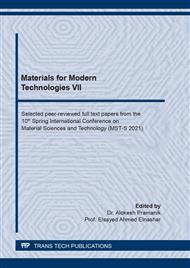p.65
p.74
p.84
p.93
p.102
p.109
p.117
p.122
p.129
Processing of Agglomerates and Pellets Containing Various Amounts of Titanium Dioxide
Abstract:
Questions about the oxidative roasting of iron ore raw materials (agglomerates and pellets) are studied. Features of the phase structure of the iron ore raw materials containing titan and vanadium are discussed. Reducibility, durability, and the softening and melting temperatures of metallurgical iron ore raw materials are studied in vitro. The objects of the research are titaniferous ores containing different amounts of titan dioxide. The behaviors of agglomerates and pellets in a blast furnace are studied, and the influence of their physical and chemical properties on heat and mass transfer processes are researched by means of a mathematical model. The main indices of blast furnace smelting—productivity, coke consumption, composition of top gas, cast iron, and slag—are shown. It is established that the increase in titanium dioxide content in pellets, as the amount of concentrate with increased TiO2 content increases, does not cause deterioration in the quality of iron ore raw materials being prepared for blast furnace smelting. At the same time, as the hot strength of raw materials increases, the temperature at which softening begins increases and the temperature interval of softening of materials decreases.
Info:
Periodical:
Pages:
102-108
Citation:
Online since:
April 2021
Keywords:
Price:
Сopyright:
© 2021 Trans Tech Publications Ltd. All Rights Reserved
Share:
Citation:


